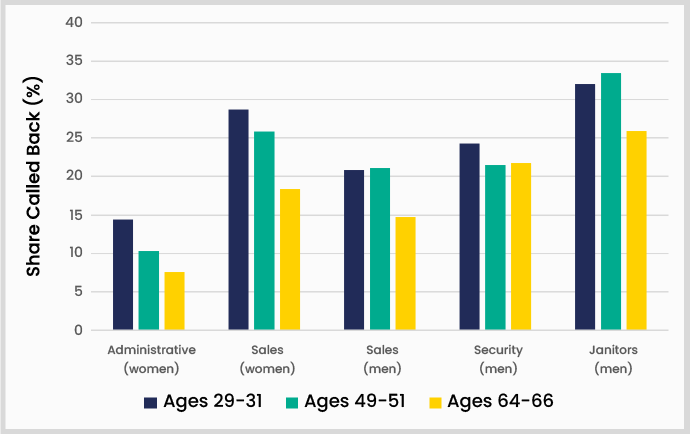
Professor Ian Burn's research responds to some of the key questions regarding age discrimination in recruitment and explains how this specifically affects women looking for jobs from as early as 40 years of age.
Britain’s population is getting older, which is leading to structural changes in our economy.
As dependency ratios rise, an aging population puts pressure on public finances, making increasing employment among older individuals a policy imperative.
In this context, age-related programmes aimed at expanding the length of working lives and promote the hiring of older individuals can be an important part of the solution.
However, age discrimination is a barrier faced by many older workers which discourages them from staying in the labour market.
Women invited less to interviews than men as they age
How this discrimination evolves as one ages is an important question, since much of the efforts to improve working lives focus on older workers in their 60s.
It’s not an easy task to measure how much age discrimination older workers experience, because age is correlated with so many other outcomes.
In my paper, “Is it harder for older workers to find jobs? New and improved evidence from a field experiment”, we measure the levels of discrimination faced by older workers using a field experiment.
We conduct a large correspondence study, sending three fake but nearly identical CVs, except for the age of the applicant, to real job openings to observe whether age changes employer’s willingness to call an applicant in for an interview.
We find significantly lower callback rates for older workers, with discrimination being worse for older women.

Interview Callback Rates by Age, Gender, and Occupation. Source: Neumark et al. (2019). “Is it harder for older workers to find jobs? New and improved evidence from a field experiment”
This is supported by a later paper, “What does a job candidate's age signal to employers?”, where I present further evidence that discrimination faced by women begins at younger ages than for men, and is more severe in magnitude.
We research how call back rates decline over time between 32-63 years of age, and found that women are invited to job interviews less once they reach 40, while men do not experience declines in callback rates until their 50s.
While age discrimination for men starts closer to when skills and productivity begin to be affected by age, our results suggest appearances play a significant role in determining when a woman begins to experience age discrimination.
Are women put off by ageist language in ads?
If policymakers want to reduce age discrimination and the negative effects of stereotyping against older workers, we have to be able to quantify the effect of these stereotypes on the decisions of older workers to apply for jobs.
In my paper, “Does ageist language in job ads predict age discrimination in hiring?”, I draw on the results from our correspondence study to better understand how ageist stereotypes are used in job-ad language and how this affects age discrimination in hiring.
We find that job-ad language related to ageist stereotypes, even when the language is not blatantly or specifically age-related, deters older workers from applying for jobs.
For men, language including age-related stereotypes sometimes predicts hiring discrimination in all three categories considered—health, personality, and skill.
However, for women it is age stereotypes about personality that predict differential hiring by age, meaning older women hired less when job ads reference traits such as adaptability, dependability or warm personality.
In my paper, “Help really wanted? The impact of age stereotypes in job ads on applications from older workers”, I test how older job seekers (older than 40) react to these ageist stereotypes.
In female-dominated occupations, workers are fairly unresponsive to ageist stereotypes in job ads, with average ages of applicants falling by 1.4 years, and the share of applicants over the age of 40 falling by 5.1%.
In contrast, in male-dominated occupations the average age falls by 5.0 years, and the share of applicants over the age of 40 falls by 12%.
This suggests women are less likely to not apply for a job when it uses language which predicts discrimination by employers.
It’s an open question why this may be, but perhaps the widespread discrimination experienced by women means they feel there are fewer employers who aren’t discriminatory so they have nothing to lose by not applying.
Men may feel they can find less discriminatory employers if they wait, so they do not feel the need to apply in the face of discriminatory language.
Author | |
|---|---|
|
|
Chair in Applied Microeconomics, University of Liverpool Management School |
